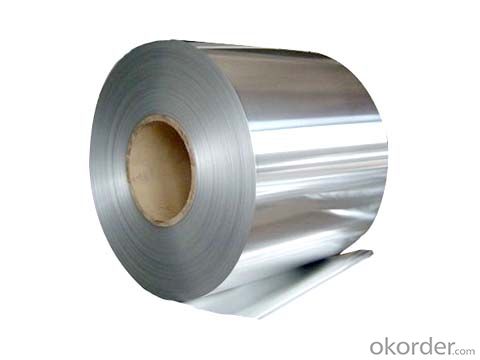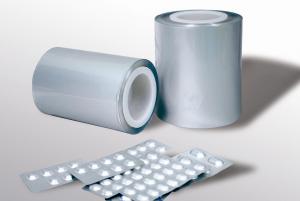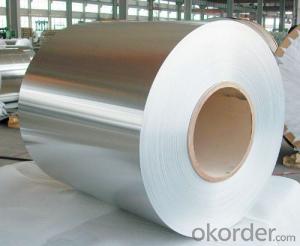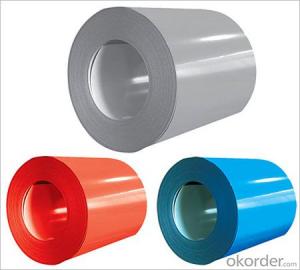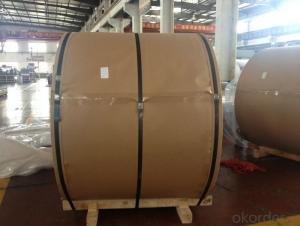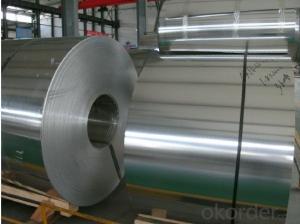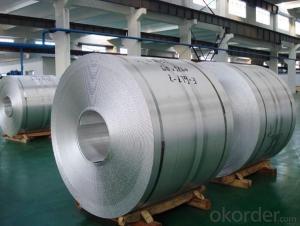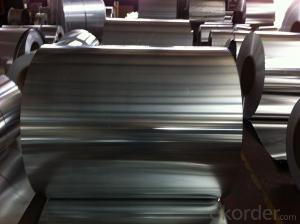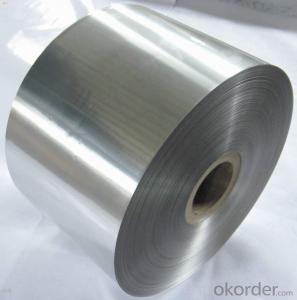Rustic Red Aluminum Coil in Georgia - C.C AA1070 Aluminum Coils for Building Material
- Loading Port:
- Shanghai
- Payment Terms:
- TT OR LC
- Min Order Qty:
- 3 m.t.
- Supply Capability:
- 10000 m.t./month
OKorder Service Pledge
OKorder Financial Service
You Might Also Like
Specification
1.Structure of C.C AA1070 Aluminum Coils used as BUiding Material Description
C.C AA1070 Aluminum Coils used as BUiding Material widly used in decoration field. For the painting, it depends on the using evironment. If you use in the open air, we recommend the PVDF coated aluminium coils. This kind of painting can last 15-20 years. If you use in the room, we recommend PE coated aluminium coils. The price is much more competitive.
Direct Continuous Aluminium Foil Stock in Coil is one semi-finished aluminium material. This strip can be rolled down to aluminium foil.The final thickess can be 5-20 microns. Aluminium foil is soft, ductile and with a silver-white luster which can be widely used in a large scare of fields.
2.Main Features of C.C AA1070 Aluminum Coils used as BUiding Material
a.Competitive price---We have our own mills and can produce mill finished aluminium coils, so we can control the production cost better.
b.Professional after-sale service---We have more than 15 years exportation experience and you need not worry about the exporation problems.
c.Fast delivery time---We can control the delivery time within 35 days.
3.C.C AA1070 Aluminum Coils used as BUiding Material Images



4.C.C AA1070 Aluminum Coils used as BUiding Material Specification
Alloy | AA1070 |
Temper | H14, H16, H18, H22, H24, H26, H32, O/F |
Thickness | 0.2mm -- 100mm |
Width | 30mm -- 1700mm |
Standard | GB/T 3880-2006,EN |
5. FAQ of C.C AA1070 Aluminum Coils used as BUiding Material
A.How to guarantee the quality?
Customers are welcome to our mill to visit and check the products. Besides, we can arrange a third party to test C.C AA1070 Aluminum Coils used as BUiding Material.
B.When will you deliver the products?
C.C AA1070 Aluminum Coils used as BUiding Material will be delivered within 35 days after receiving advanced payment or original L/C.
- Q: What are the different tempers available for aluminum coils?
- There are several different tempers available for aluminum coils, each offering unique characteristics and properties. The most common tempers include: 1. O Temper: Also known as annealed or soft temper, this is the softest and most ductile temper available. It is characterized by low strength and high formability, making it suitable for applications that require extensive forming or bending. 2. H Temper: The H temper series includes various levels of work hardening, resulting in increased strength and reduced formability compared to the O temper. The H temper range includes H1X, H2X, H3X, H4X, H5X, and H6X, with each subsequent number indicating a higher level of work hardening. These tempers are commonly used in applications that require moderate to high strength. 3. T Temper: The T temper series, also known as heat-treated tempers, involves thermal treatments to achieve a specific combination of strength and formability. The most common T tempers include T3, T4, T6, and T7. T3 and T4 are solution heat-treated and naturally aged, providing a good balance of strength and formability. T6 and T7 are solution heat-treated and artificially aged, resulting in higher strength but reduced formability. 4. F Temper: The F temper, also known as as-fabricated temper, is obtained by hot working or cold working the material without subsequent thermal treatments. It offers improved strength and hardness compared to the O temper but lower than the H and T tempers. These different tempers allow aluminum coils to be used in a wide range of applications, from automotive parts and aerospace components to building materials and consumer goods. The choice of temper depends on the specific requirements of the application, including desired strength, formability, and corrosion resistance.
- Q: Can aluminum coils be used in the production of electronic components?
- Yes, aluminum coils can be used in the production of electronic components. Aluminum is a commonly used material due to its lightweight, conductivity, and corrosion resistance properties. It is often used in electronic devices such as capacitors, inductors, and transformers.
- Q: How to purchase PE polyester coated aluminum sheet and PVDF fluorocarbon coated aluminum coil?
- Both belong to color coated aluminum sheet and coil. Customers can purchase ordinary aluminum sheet or coil, and then go to special coating company to add PE polyester coating or PVDF fluorocarbon coating. The color is bright and quality is also very good. PE polyester coated aluminum and PVDF fluorocarbon coated aluminum coil has a wide range of usages: construction industry (aluminum-plastic panel, aluminum honeycomb, roof corrugated sheet, fireproof veneer, aluminum ceiling, shutter, rolling shutter door, garage door, awning, water gutter), electronic appliances (computer chassis, computer panel), lighting, furniture, solar reflector, air conditioning duct and the like. At present it is still applied in many areas including electronic appliance, instrument, lighting, packaging and house decoration.
- Q: Can aluminum coils be used in heat exchangers?
- Yes, aluminum coils can be used in heat exchangers. Aluminum is a popular choice for heat exchangers due to its excellent thermal conductivity and corrosion resistance. The high thermal conductivity of aluminum allows for efficient heat transfer, making it an ideal material for heat exchangers. Additionally, aluminum's corrosion resistance ensures that the coils will remain durable and functional even in harsh environments.
- Q: Can aluminum coils be used in building facades?
- Building facades can indeed incorporate aluminum coils. Due to its numerous advantages, aluminum is a favored material for such applications. Its lightweight nature, durability, and resistance to corrosion make it ideal for exterior use. Furthermore, aluminum coils can be shaped into various forms and sizes, enabling limitless design possibilities. Additionally, aluminum offers a wide selection of finishes, such as anodized, painted, and coated, enhancing customization options for building facades. Moreover, aluminum is an environmentally sustainable material as it can be 100% recycled, making it an eco-friendly choice for construction projects. In conclusion, aluminum coils offer both aesthetic appeal and functional performance, making them a feasible choice for building facades.
- Q: What are the potential health hazards associated with the use of old aluminum coils?
- <p>Using old aluminum coils can pose health risks due to potential leaching of aluminum into food or beverages. Long-term exposure to aluminum may lead to cognitive impairments and neurological issues. Additionally, old coils may have accumulated dirt, bacteria, or other contaminants that could cause infections or digestive problems. It's important to regularly inspect and replace aluminum cookware to ensure safety.</p>
- Q: I am looking for a deoderant that doesn't contain aluminum that actually works. I have tried Tom's natural deoderant and didn't get to use it long enough to see if it worked because it really irritated my skin and caused it to burn and peel. I have also tried the one made by Adidas and it seemed to work pretty well through the winter months, but now that it is getting warm again I'm noticing that it isn't quite doing the job anymore.
- aluminum zirconium is the chemical that makes you stop sweating, not that it works on most people. they can only put a certain percentage of it in deodorants, try the degree clinical, i just started using it and it seems to be doing okay, good luck i know what you are going through.
- Q: How are aluminum coils stored in a warehouse?
- Aluminum coils are typically stored in a warehouse by stacking them vertically or horizontally, depending on the size and weight of the coils. They are often placed on pallets or racks to maximize storage space and ensure stability. Additionally, protective packaging materials, such as plastic or cardboard, may be used to prevent damage and maintain the integrity of the coils during storage.
- Q: What are the common coil inner diameters for aluminum coils?
- The common coil inner diameters for aluminum coils can vary depending on the specific application and industry requirements. However, some commonly used inner diameters for aluminum coils are 150 mm (5.9 inches), 200 mm (7.9 inches), and 300 mm (11.8 inches). These inner diameters are often chosen based on factors such as the coil's size, weight, ease of handling, and compatibility with manufacturing equipment. It is important to note that these are just a few examples, and the actual inner diameters may vary depending on the specific needs of each industry or application.
- Q: What is the role of aluminum coils in the construction of railways?
- Aluminum coils play a critical role in the construction of railways. They are commonly used in the manufacturing of railway tracks and train cars due to their unique properties and advantages. One of the main roles of aluminum coils in railway construction is their contribution to lightweighting. Aluminum is a lightweight material, making it ideal for reducing the overall weight of railway components. This is important because lighter trains and tracks require less energy to operate, resulting in improved fuel efficiency and reduced operating costs. Additionally, the reduced weight of aluminum components allows for increased payload capacity, enabling trains to carry more passengers or freight. Another crucial role of aluminum coils is corrosion resistance. Railways are subjected to various environmental conditions, including moisture, salt, and extreme temperatures. Aluminum has excellent corrosion resistance properties, making it highly durable and long-lasting even in harsh environments. This reduces maintenance and replacement costs associated with rust and corrosion, ensuring the longevity and reliability of the railway infrastructure. Moreover, aluminum coils offer excellent conductivity, which is essential for electrical and signaling systems in railways. Aluminum's high electrical conductivity allows for efficient power transmission and distribution, enabling seamless communication between trains, signaling devices, and control systems. This contributes to the safety and efficiency of railway operations. Furthermore, aluminum coils can be easily formed and fabricated into various shapes, enabling flexibility in railway design and construction. This versatility allows for the production of customized railway components, such as curved tracks or aerodynamic train carriages, to meet specific project requirements. In summary, the role of aluminum coils in the construction of railways is vital due to their lightweight, corrosion-resistant, conductive, and versatile nature. Their use in railway infrastructure results in numerous benefits, including improved fuel efficiency, reduced maintenance costs, enhanced safety, and the ability to design and construct innovative railway systems.
Send your message to us
Rustic Red Aluminum Coil in Georgia - C.C AA1070 Aluminum Coils for Building Material
- Loading Port:
- Shanghai
- Payment Terms:
- TT OR LC
- Min Order Qty:
- 3 m.t.
- Supply Capability:
- 10000 m.t./month
OKorder Service Pledge
OKorder Financial Service
Similar products
Hot products
Hot Searches
Related keywords




